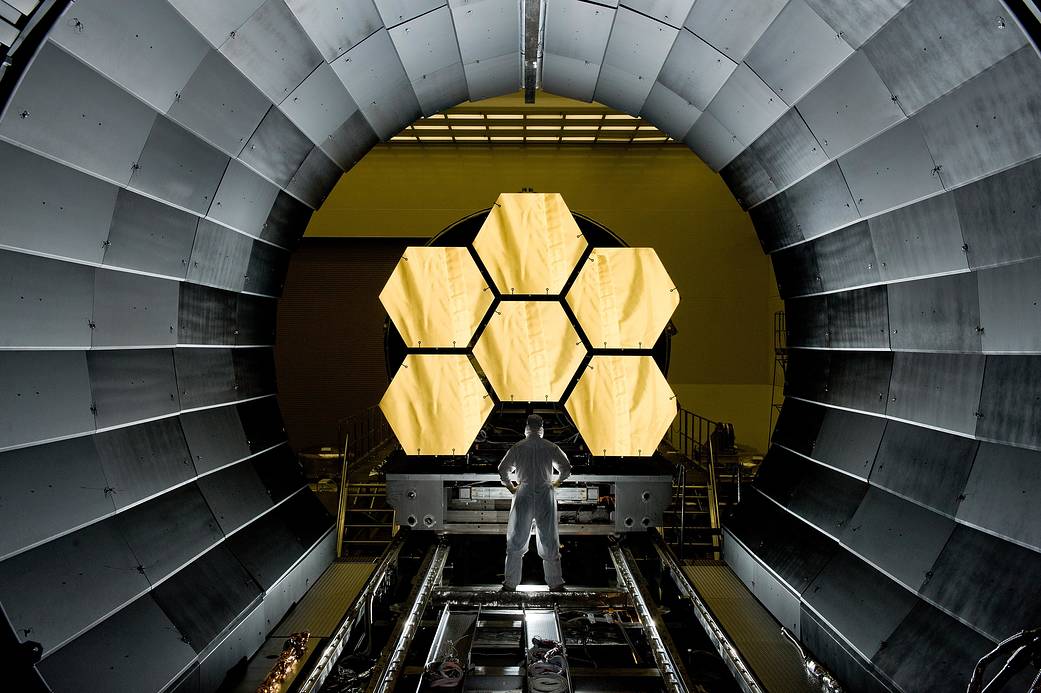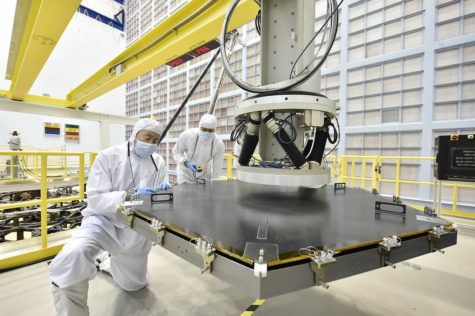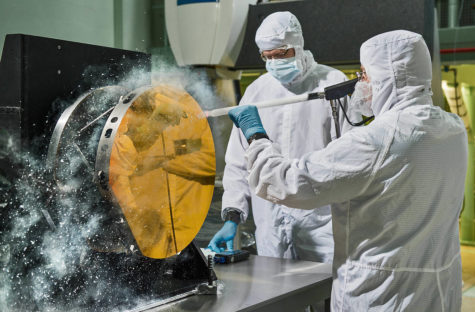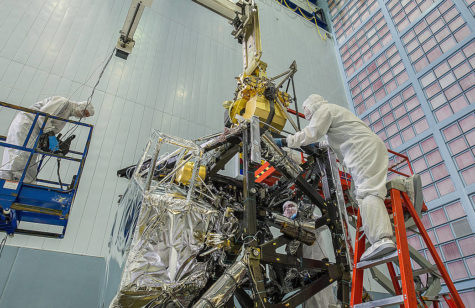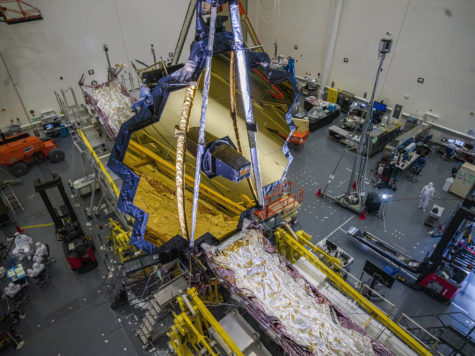James Webb Telescope: The Telescopic Titan of Infrared
A Retrospective Look at NASA's Most Powerful Telescope to Date
January 22, 2023
On December 25, the James Webb space telescope, the largest, most powerful and complex space telescope built to

date, celebrated its first anniversary adrift in space. The Webb telescope peers into deep space, capturing distant galaxies in extraordinary detail as it coasts to the outer reaches of our Solar System in search of the answers to the fundamental questions of our universe.
As the holiday season is a time of remembrance and reflection, it only seems appropriate to look back at Webb’s journey. From its creation, to its launch, to where it’s been, and where it’s going; this is Webb: A Retrospective.
Development History
The story of Webb begins in September of 1989. Eight months prior to the launch of NASA’s Hubble Space Telescope, the first major optical space-based telescope, a conference was held between NASA and the Space Telescope Science Institute (STScI) to discuss the viability of a next-generation space telescope. At the
time, Hubble’s projected decommissioning was placed in 2005, and Riccardo Giaccino, Director of STScI, was concerned with the time required for these massive projects (Hubble, for instance, took 12 years to construct) suggested that they hold a conference to consult the idea of a follow-up telescope. The conference, known as The Next Generation Space Telescope Workshop, was hosted by STScI with support from NASA and NASA’s Goddard Space Flight Center. With some 130 astronauts, scientists, and engineers in attendance, they began planning Hubble’s successor.
In May of 1996, the “HST (Hubble Space Telescope) and Beyond Committee”, a small, 18-member committee appointed by the Associations of Universities for Research of Astronomy (AURA, parent organization of STScI), sent a detailed report to NASA, recommending they explore the feasibility of an infrared telescope. Such technology would allow them to look into the formation of distant galaxies, and unravel some of the mysteries behind the origins of the universe.
The idea was promising, but wasn’t without technical challenges. The telescope would need to be massive- the largest space-based telescope ever built. It would need to possess a large primary mirror capable of absorbing and transcribing the data from the faint, low infrared wavelengths from deep space, while simultaneously keeping the telescope consistently cold in order to detect the heat radiation from the infrared light, while having to operate far

outside of Earth’s orbit, going well beyond the scope of the moon. It would be a monumental task. But, was it even possible? Three teams of scientists and engineers from independent government and aerospace organizations met to evaluate if NASA could execute the Committee’s vision, and all three teams determined the proposed telescope could work.
NASA assigned teams from Lockheed Martin and TRW, two aerospace engineering firms, to perform “Phase A” of the project: conducting individual studies on a potential design for the telescope, as well as the financial aspects of construction. NASA eventually selected TRW’s design in 2002 to continue with construction. Additionally, the telescope obtained support from its first international partners, the European Space Agency (ESA) and Canadian Space Agency (CSA). Finally, the Next Generation Space Telescope received a name change: The James Webb Space Telescope, renamed for the administrator who oversaw a fledgling NASA during the Apollo Missions.
Construction would begin in 2004, specifically for the scientific instruments and the 18 hexagonal segments which would make up the primary mirror, as those were the parts that required the most time to perfect. NASA would bear the brunt of construction, building the actual spacecraft, telescope, and developing some of Webb’s scientific instruments. The European Space Agency would also aid by working to build the spacecraft’s Near-Infrared Spectrograph, and Mid-Infrared Instrument, which would be Webb’s primary infrared provide members of staff to aid management on ground control, and, most crucially, provide a rocket- an Ariane 5- to launch Webb into its operating orbit. Canada would assemble Webb’s Near-Infrared Imager and Slitless Spectrograph, which are specialized to capture the infrared emissions from far off planets as well as the Fine Guidance sensor. By 2006, the first few instruments were passing critical design reviews, and all technologies were successfully tested under flight conditions. Main construction continued, as similar tests were performed on the various instruments over the course of the next few years.
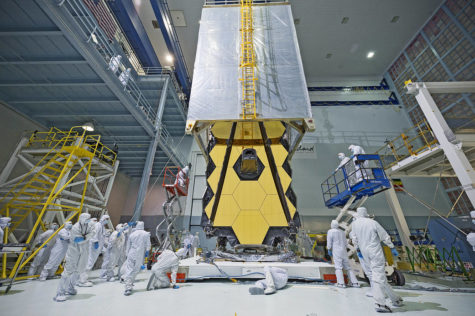
Most of the work in the decade that followed now fell to continuous testing and assembly of the instruments and mirror segments, as well as manufacturing of other parts like solar panels and fuel tanks. Goddard Space Flight Center would collect the instruments developed by the teams in Europe and Canada. The segments of Webb’s primary mirror and secondary mirror were slowly delivered to Goddard from Ball Aerospace. The backplane structure, meant to hold the many segments of the primary mirror, was completed by Northrop Grumman and partner ATK, but further cryogenic testing was needed to ensure that the instruments weren’t vulnerable to heat once in space. October of 2015 saw the mounting of the primary and secondary mirror to the backplane structure, giving the telescope its signature shape. Testing was finalized by December 2017.
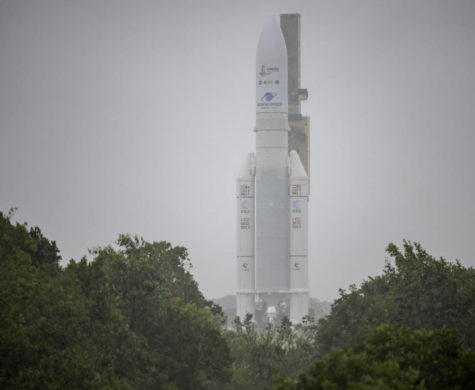
Finally, after 3 decades of speculating, planning, and construction, Webb launched on Christmas morning, December 25, at 7:20 a.m. EST, at the European Space Agency’s launch site in Kourou, French Guiana.
The Wonders of Infrared: A new view of the Universe
Infrared light is a form of invisible electromagnetic radiation, most notably known as the radiation of heat. It allows us to view things with thermal imaging and change TV channels from the couch, but, how is it relevant to astronomy? In space, most objects are too faint or far away to be properly detected in the visible spectrum. Additionally, the large groups of cosmic dust clouds that inhabit sites of early star formation, scatter the visible light, obstructing our view of space. Infrared radiation is more freely able to pass through the dust, revealing large portions of space that would otherwise be hidden away behind the thick cosmic clouds. Another benefit of using infrared light is due to a process known as redshift. As the universe continually expands, shorter, high frequency “blue” wavelengths, become stretched out into longer, low frequency “red” wavelengths, falling into the infrared spectrum. These factors make infrared an incredibly potent tool for space observation. In fact, Webb is far from the first infrared telescope to gaze upon the stars.
Infrared light was discovered in 1800 by Sir Frederick William Herschel, a German born British astronomer whose other noteworthy accomplishments include the discovery of Uranus, and several moons from Saturn and Uranus. The first application of Infrared light to astronomy occurred in 1856, when astronomer Charles Piazzi Smyth, using a thermocouple, a device more acutely aware of temperature change than the standard mercury thermometer, detected infrared radiation coming from the full moon.
The first infrared satellite was the Infrared Astronomical Satellite (IRAS) launched in 1983. The satellite proved the technology’s worth, generating the first detailed infrared maps of the sky. Piggybacking off the success of IRAS, the European Space Agency developed the next major step in astronomical infrared technology, the first general Infrared Space Observatory, or ISO, which operated from 1995 to 1998. NASA would try their hand at an infrared telescope, creating the Spitzer Space Telescope. Spitzer launched in 2003, serving as NASA’s primary infrared observatory prior to its decommissioning in January 2020.
Webb vs. Hubble
Both Hubble and Webb are reflecting telescopes, using concave mirrors to bend light into their various scientific instruments. Webb is significantly larger than Hubble, a necessity in order to support its massive, 18-segment beryllium monster of a primary mirror. Sitting at 21.3 ft (6.6 meters) in length, it significantly dwarfs Hubble’s 7.8 ft (2.4 meters) mirror. The size of the primary mirror enables Webb to catch as many redshifted light waves as possible. To add a cherry on top, each mirror segment wears a golden coat to maximize the reflection of infrared light. All these factors and more contribute to an infrared powerhouse of a space telescope. Consider that with Hubble’s ultraviolet coverage, and the two telescopes make a versatile pair. Hubble is definitely the senior of the two, having operated an astonishing 30 years. Generally, space telescopes serve for about 10-15 years, (or however long the scope of their mission requires, before being decommissioned). Indeed, this was originally the plan for Hubble too. However, Hubble’s location just outside 535 km (332 miles) away, just outside Earth’s atmosphere, allowed it a unique opportunity. Astronauts are able to routinely check-up and perform repairs and upgrades to the technology, significantly expanding its lifespan. Today, Hubble is still going strong, and remains a titan of space observation. Webb, however, will not be afforded the same luxury. Webb will orbit the Lagrange 2 point, roughly 1 million miles away from home, collecting data as it orbits the sun. Thanks to a precise launch, Webb will have enough fuel to last at least 10 years of operation, but will not likely reach the age of Hubble.


Webb and the Future
Ambition has fueled the exploration of space ever since the first man-made object left Earth’s atmosphere. It has rapidly pushed humanity and technology to frontiers once thought impossible, thrusting humanity into a new age. Being the largest, most expensive, and technologically advanced space telescope to ever leave Earth’s orbit, Webb is nothing if not a product of ambition. In a single year, Webb has considerably enhanced our understanding of star birth, revealing hundreds of stars hidden in nebulae. Many scientists anticipate what Webb may uncover on its quest to the evolution of our universe.

